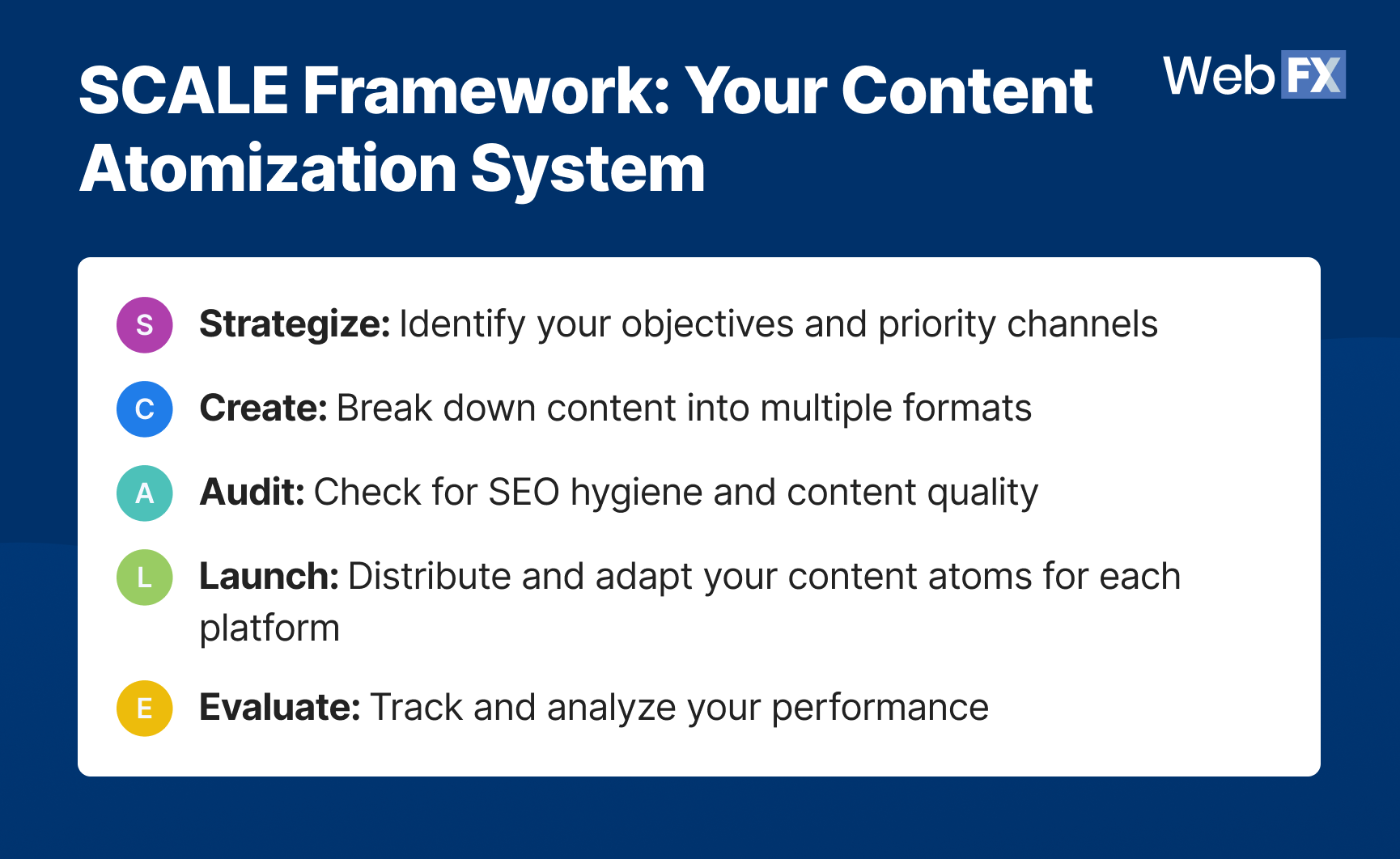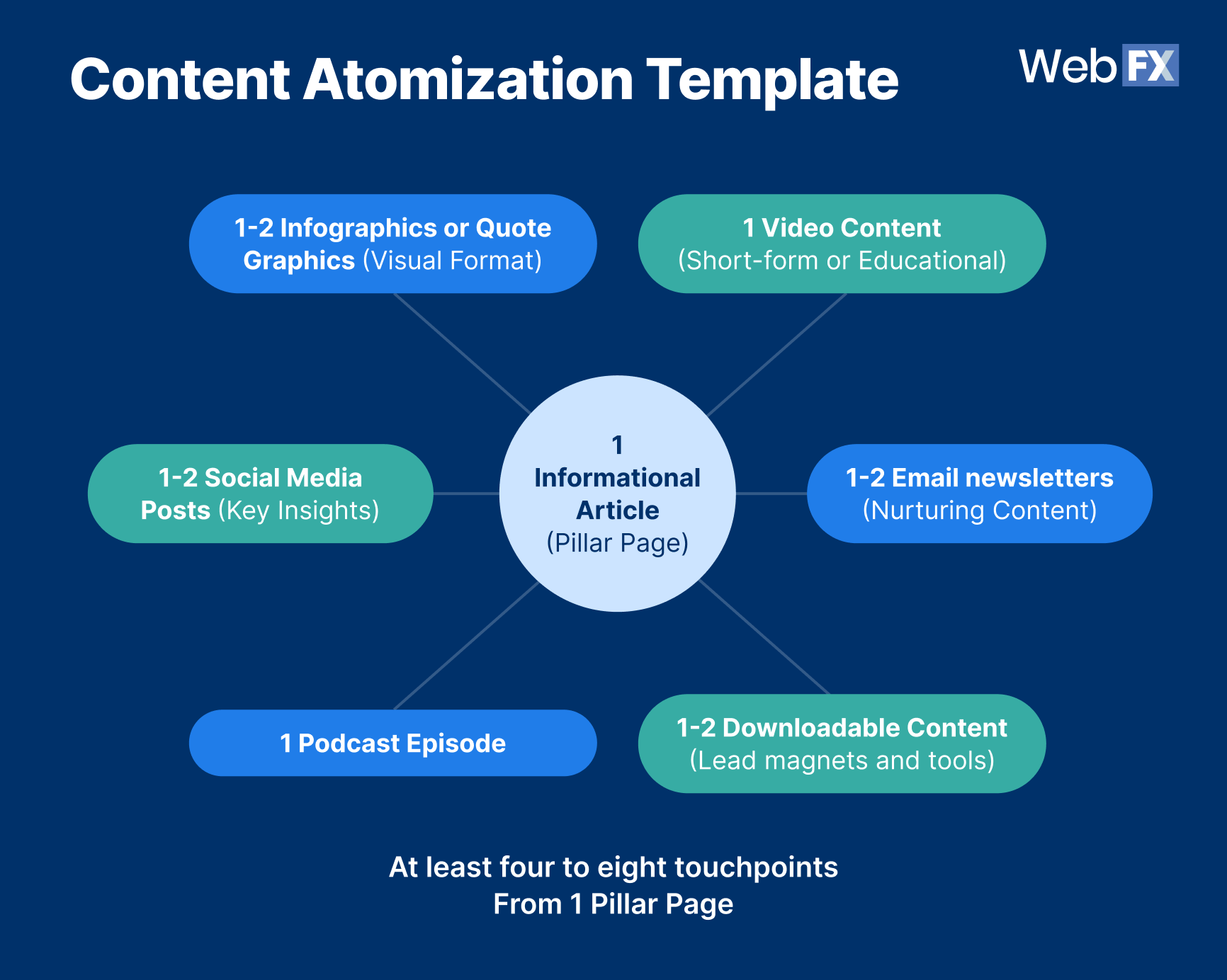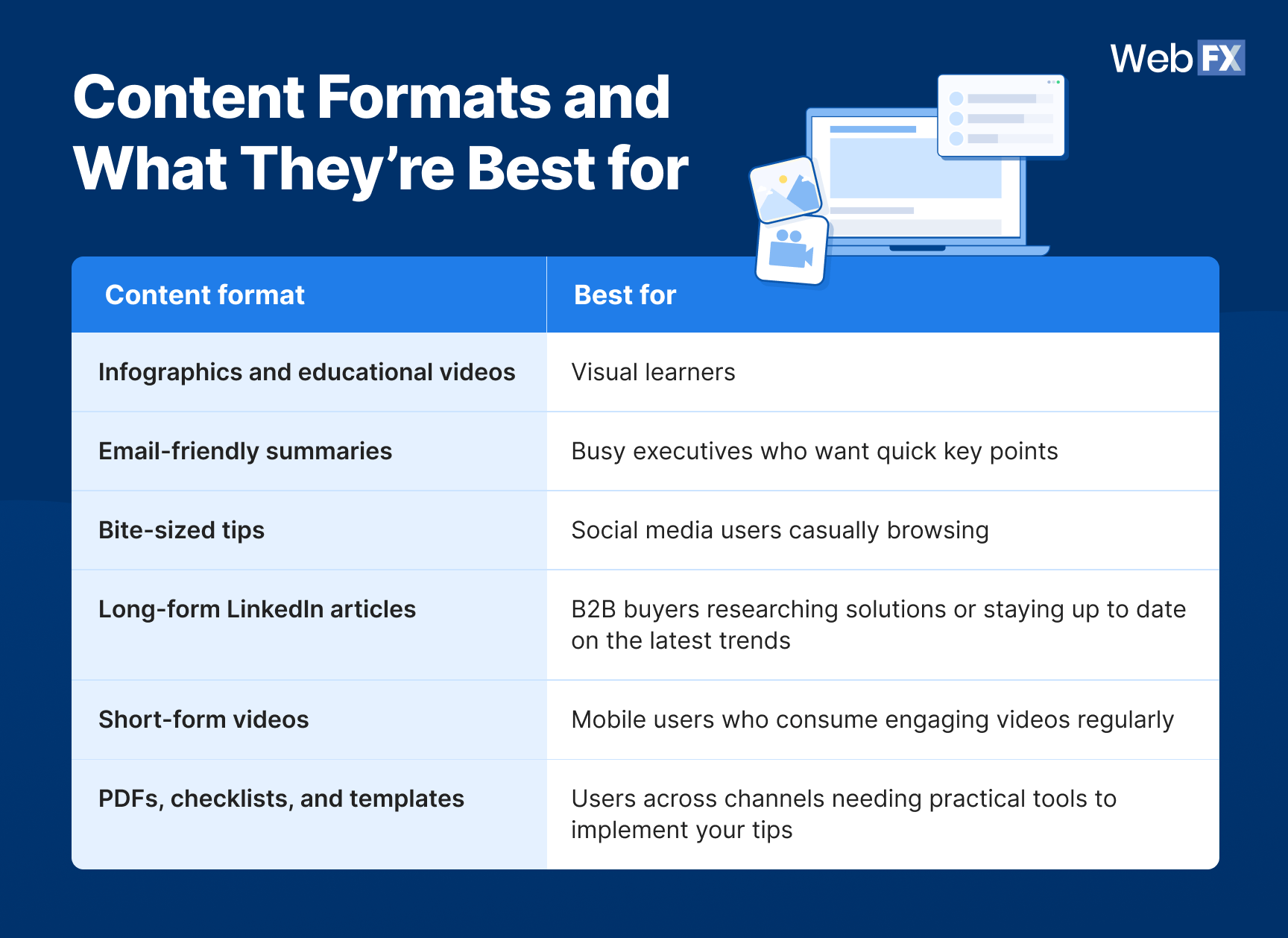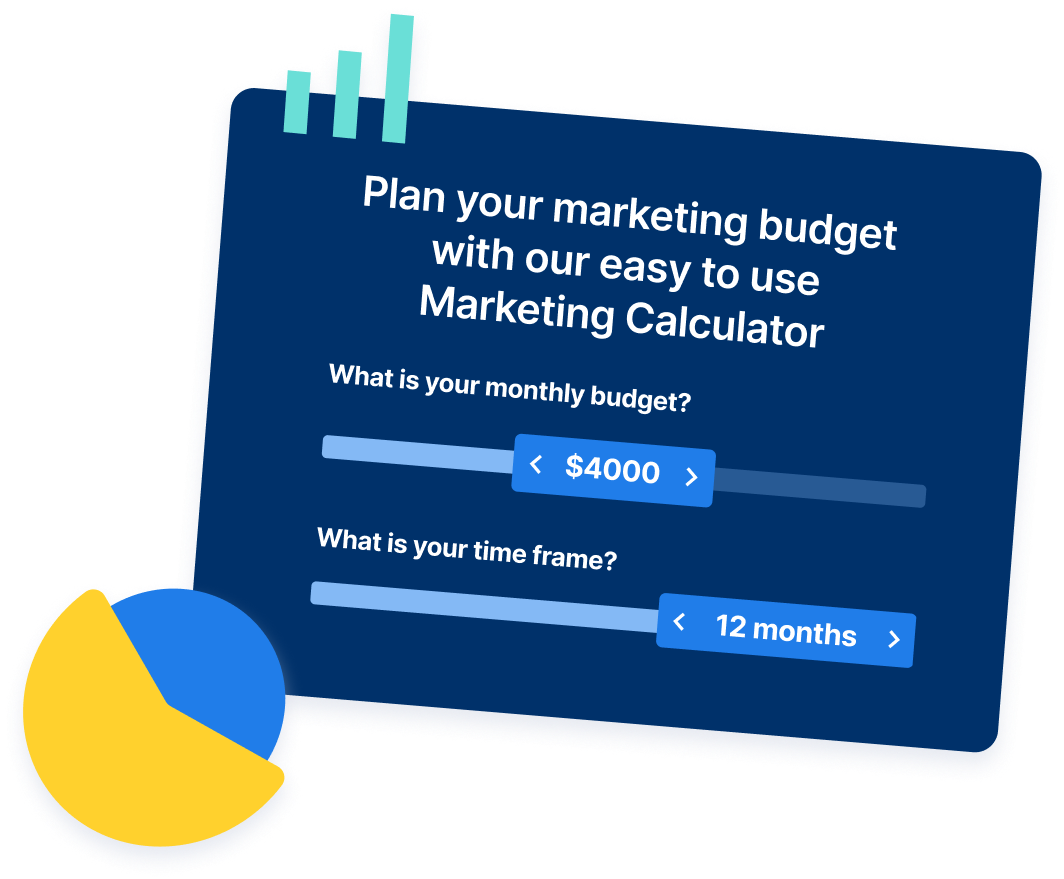- Home
- Blog
- Content Marketing
- One Asset, 8 Touchpoints: Your Guide to Creating Hard-working Content That Boosts ROI
One Asset, 8 Touchpoints: Your Guide to Creating Hard-working Content That Boosts ROI
-
 Published: Oct 15, 2025
Published: Oct 15, 2025
-
 9 min. read
9 min. read
-
Summarize in ChatGPT
-
 Maria Carpena
Maria Carpena Lead Emerging Trends & Research Writer
Lead Emerging Trends & Research Writer
- Maria is a Lead Emerging Trends & Research Writer at WebFX. With nearly two decades of experience in B2B and B2C publishing, marketing, and PR, she has authored hundreds of articles on digital marketing, AI, and SEO to help SMB marketers make informed strategic decisions. Maria has a degree in B.S. Development Communication major in Science Communication, and certifications in inbound marketing, content marketing, Google Analytics, and PR. When she’s not writing, you’ll find her playing with her dogs, running, swimming, or trying to love burpee broad jumps.
Table of Contents
- Why content atomization matters to SMBs
- Create multiple lead-generating touchpoints with the SCALE framework
- Strategize: Identify your objectives and priority channels
- Create: Break down content into multiple formats
- Audit: Check for SEO hygiene and content quality
- Launch: Distribute and adapt your content atoms for each platform
- Evaluate: Track and analyze your performance
- Implementing content atomization in 12 weeks [checklist]
- When you should not atomize (and what to do instead)
- 1. Your business must focus on your current operations
- 2. Your business must focus on creating real-time content over evergreen content
- 3. Your atomized content’s review process is time-consuming
- 4. Your content doesn’t meet the atomization readiness criteria
- 5. Your organization’s content creation strategy isn’t connected to business goals
- Amplify your content’s impact on your ROI

Key takeaways
- Content atomization is the strategy of breaking down large, high-value content into smaller content pieces or “atoms” that you can publish and distribute through different channels.
- The SCALE framework is a five-step system to turn a substantial content piece into multiple touchpoints that attract leads to your business:
- S – Strategize: Identify your objectives and priority channels
- C – Create: Break down content into multiple formats
- A – Audit: Check for SEO hygiene and content quality
- L – Launch: Distribute and adapt your content atoms for each platform
- E – Evaluate: Track and analyze your performance
You’ve invested hours creating quality content for your business. You share it on social media and send it to your newsletter list.
You wait for the leads to roll in but only see a modest trickle. So now you wonder: Is there a better way to maximize my content marketing investment?
The answer is yes! Your content can work as hard as you. Instead of creating new content from scratch every day, successful small- to medium-sized businesses (SMBs) use content atomization to improve their content’s reach and generate more leads for their business.
Content atomization refers to breaking down large, high-value content (such as original research, white papers, or webinars) into smaller pieces or “atoms” that you can distribute through different channels.
Learn how you can implement this strategy and turn your high-value content into multiple touchpoints that drive leads with these topics:
- Why content atomization matters to SMBs
- The SCALE framework: Your step-by-step atomization system
- 12-week implementation checklist
- When you should not atomize (and what to do instead)
Why content atomization matters to SMBs
Content marketing is three times more efficient at generating leads than outbound marketing. However, here’s what typically happens: SMBs create new content, share it on a few channels, and repeat the process with new content.
Meanwhile, they’re competing against bigger companies with dedicated content teams that maintain their market presence with content everywhere. The traditional advice to just keep creating content is an inefficient approach that can stretch your team thin.
Content atomization helps you work smarter, not harder. Instead of always churning fresh content, you maximize the value of what you’ve already created.
With content atomization, you:
- Create four to eight touchpoints: Break down one well-researched blog post into multiple assets, such as infographics, a downloadable checklist, social media posts, and short-form video. That way, you’re giving your prospects more ways to discover your business.
- Serve different content preferences: No matter how much effort you put into an original research piece, the truth is that not all your prospects like reading long-form content. Content atomization generates various content pieces for you, potentially attracting audiences with different content preferences.
- Make proven content work harder: Instead of one whitepaper generating leads, you have videos and blog posts that create more opportunities to engage your prospects.
Think of content atomization as a cook who takes one roast chicken dinner and turns it into soups, sandwiches, and salad for the rest of the week.
Content atomization works smartly like this cook. It takes your existing content and amplifies its reach without drastically increasing your workload. As a result, you get improved ROI from every hour you’ve invested in creating content.
Create multiple lead-generating touchpoints with the SCALE framework
Here’s your five-step framework to systematically turn a content piece into multiple touchpoints that attract leads to your business:

Strategize: Identify your objectives and priority channels
Start by defining what you want your content to achieve. Then identify your highest-impact distribution channels that can deliver the results.
The goal of atomization is not to be everything, everywhere, all at once. Focus your efforts on high-value “atoms” or content and the top-performing channels that will deliver the maximum ROI.
Special note for regulated industries like healthcare, finance, and legal: Businesses in these sectors may need to consult their subject-matter experts and legal teams to approve their atomized content to ensure they’re accurate and compliant with disclosure, privacy, and other rules.
Your strategy checklist
Define your primary goal for atomization
Do you want your bite-sized content pieces to generate leads, improve your brand awareness, or support your sales teams? Determine the goal you’re working towards to set clear expectations.
Identify three to four channels where your audience is highly engaged
Which channels do your prospects use regularly to interact with you?
Use analytics tools like Google Analytics 4 to identify your best-performing channels. Pick platforms that not only drove site visitors, but also conversions.
LinkedIn is a common channel among B2B businesses, because over 60 million of the platform users are decision-makers for their companies. Email is also another popular B2B channel, with 50% of US B2B marketers claiming that email marketing is their most effective channel.
Set realistic targets
Use your current content performance as a baseline and target a two to three times improvement of your pillar content and its “atom” content.
For example, if your blog post typically generates two leads, aim for four to six leads across all your atomized pieces combined.
Choose your pillar content piece(s)
Select existing content that has performed well (in terms of engagement and generating leads), or addressing your customers’ biggest pain points.
Use the content atomization readiness criteria checklist below to evaluate your content and prioritize pieces based on performance and strategic performance.

Content atomization readiness criteria
Before atomizing a particular content piece, ensure it meets these criteria:
- Contains at least three to four unique insights, tips, or data points that can stand alone as a valuable blog post, infographic, or short-form video
- Addresses a customer pain point that they consult you about often
- Has generated leads or engaged your audience in the past
- Provides genuine value by educating, solving problems, or offering actionable advice to your ideal customers
- Is substantial enough (typically at least 800-word written content or original research) to break into meaningful, useful content pieces
Create: Break down content into multiple formats
Break your pillar content into smaller, valuable content pieces that cater to your prospects with different consumption preferences. Each content piece must be helpful for your prospects on its own — it must be meaty and free from fluffy extenders.
Your checklist for creating “atoms”
Identify three to four key insights from your pillar content
What are the top key takeaways from the content that could stand alone as individual pieces?
Consider turning them into:
- Blog posts on key insights
- Social media posts highlighting key statistics, insights, or quotes
- Quote graphics with compelling statements
- Infographics showing data, processes, flow charts, or comparisons
- Short-form video that explains step-by-step processes
- LinkedIn articles focusing on insights
- Instagram carousel posts of multiple related tips
- Podcast talking points, if you produce podcasts
Here’s a template that you can initially use as a guide. You can revise it as you see fit as you atomize more content.
Note that you don’t have to create content for every format. Pick ones that you think will have the most impact on your business. You may also need to tweak it according to content topics unique to your business and the results you get:

Create platform-specific formats
Identify the effective ways to present your content and ideas for different content consumption preferences. Here are some formats and for whom they’re suitable:

Table View
Content format
Best for
Infographics and educational videos
Visual learners
Email-friendly summaries
Busy executives who want quick key points
Bite-sized tips
Social media users casually browsing
Long-form LinkedIn articles
B2B buyers researching solutions or staying up to date on the latest trends
Short-form videos
Mobile users who consume engaging videos regularly
PDFs, checklists, and templates
Users across channels needing practical tools to implement your tips
Plan email-friendly segments
Identify which parts of your content work best for nurturing prospects via email. Consider email-friendly elements you can atomize from your pillar content:
- Key insights or statistics
- Step-by-step processes
- Quick tips or actionable takeaways
- Case-study highlights, problem-solving stories, or lessons learned lists (great for service providers)
- Product features and benefits with real-world applications (ideal for businesses offering products)
Audit: Check for SEO hygiene and content quality
When planning your “atoms” or new pieces of content, ensure that each piece is helpful for your audience and provides a unique value in your content roster.
Your atomized content must complement — and not compete with — your pillar content in search results. It must also never hurt your other marketing efforts.
Your audit checklist
Check for keyword cannibalization
Are your atomized content pieces competing with your pillar page or one another for the same search terms? Make sure each content piece targets different keywords and search intent.
Verify each piece’s value and purpose
Ensure that each content piece provides a unique value by serving your audience in different contexts or channels.
Each atomized content asset must address a unique customer need or search intent that other “atoms” don’t. If two content pieces have the same core message, make sure they’re reaching different audiences on different platforms.
For example, let’s say you’re a pet store that published a pillar page: A long-form, informational article on dog nutrition for different life stages based on several studies.
One of the ways you can atomize this content is by creating a dedicated blog post on puppy nutrition. You can also create an infographic on the same topic, but for social media distribution.
Maintain content depth standards
Avoid creating thin content with only surface-level information that your prospects may find in AI Overviews. Short-form content must include specific details, actionable steps, and valuable expert insights.
Review for completeness and clarity
Can each atomized piece stand alone without your readers reviewing your pillar content?
Each piece must make sense by itself even if someone hasn’t read your pillar content. Of course, you can still link to your original content (that’s best practice!) and encourage them to read it.
But your atomized piece must be clear and actionable enough for your audience.
Launch: Distribute and adapt your content atoms for each platform
After creating your atomized content pieces, it’s time to distribute them strategically across your most impactful channels, with each piece customized to match the platform’s format and audience behavior. This step is about smart distribution timing and optimizing content according to channels.
Your launch checklist
Customize content format for each platform
Match the format to how people consume and engage with content on a specific platform. Check out the table below for a quick guide.
| Platform | Content Format |
| Visual content (photos, carousel, and short-form videos) | |
| TikTok | Short-form vertical video content |
| Detailed insights and professional discussion starters | |
| Conversation starters and engaging questions for a community | |
| Visual content for inspiration (product photos, infographics, and short videos) | |
| Blog posts | Focused, single-topic educational content |
| Emails | Detailed insights with actionable tips |
Optimize timing for your audience
Launch your atomized piece when your audience is likely using your specific channels.
For example, the best time to post on LinkedIn, which is popular among B2B businesses, is best done on on weekdays from 9am to 5pm. Test your timing, and adjust your distribution schedule based on your audience’s behavior on each platform.
Coordinate your content scheduling
Instead of posting everything at once, spread out related content pieces’ launch schedules days or weeks apart.
Your rollout schedule must have a consistent cadence, so you don’t overwhelm your newsletter recipients or social media followers. Here’s a publishing sample cadence for a travel agency:
- Day 1: Publish your pillar page, “The Ultimate Guide to Planning Your European Vacation for Winter”
- Day 4: Instagram carousel post highlighting budget-saving tips from the guide
- Day 7: Email newsletter with detailed budget-saving tips from the guide
- Day 10: Instagram Reel or TikTok short video showing clips of winter destinations mentioned in the guide
Then, you can start your next content cycle with different topics. By spacing out their publishing and email send dates, you’re maintaining your presence without overwhelming your prospects.
Match calls-to-action with platform behavior
Different channels encourage different types of engagement, so tailor your CTA according to the platform and your content.
For example, let’s say a hospital publishes an educational blog post on diabetes management. A service-focused CTA like “Schedule your diabetes screening today” works for the blog.
Meanwhile, an Instagram post on diabetes diagnosis and tests derived from the pillar content can have a “Save this post for later” or “Share this with a friend” CTA.
Evaluate: Track and analyze your performance
The final step of our framework is monitoring and evaluating your atomization approach’s performance and ROI. Unlike typical content performance analysis, you must:
- Measure the collective impact of related atomized pieces
- Evaluate whether your entire process improves efficiency and ROI
Analyze your performance 30 days after distributing your final atomized content piece. This gives your content time to gain traction and provides enough data for evaluation.
Your checklist for evaluating your content atomization process
Track your content atomization ratio
Count how many atomized pieces you create from each pillar content. Aim to create four to eight touchpoints from one piece of pillar content.
If you’re only getting fewer than four pieces from your pillar page, don’t fret. Some highly regulated (healthcare and legal) and technical (B2B manufacturing) industries may naturally have lower atomized content pieces. Local businesses may also have fewer content pieces because of a smaller audience and limited resources.
Measure total reach and conversion improvement
Add your pillar page’s and atomized content pieces’ metrics:
- Reach (total impressions, views, and unique visitors)
- Engagement (comments, shares, email open rates, time spent on content, click-through rates)
- Conversions (leads generated, email sign-ups from downloadable content, inquiries, and sales calls scheduled)
- Revenue (attributed sales, deals closed, or customer acquisition)
Compare the total to what your pillar content alone typically achieves. Your atomized content series’ combined reach should be significantly higher than the standalone pillar page to justify your additional effort.
For conversions, calculate the total conversion rate of your entire content series (pillar page and all atomized content pieces combined) and compare it to what a standalone pillar piece typically achieves. The atomized approach should deliver an improved average conversion rate.
Identify your highest-converting atomized formats and channels
Track which types of atomized content generate the most conversions (leads generated, inquiries, or sales calls scheduled). You can tag these formats and channels as your proven winners, so you can focus on these efforts in the future.
Evaluate overall business impact
Compare your lead generation and sales results during your atomization months with previous periods when you created individual content pieces. The goal is to determine whether this systematic approach improves your content marketing ROI.
If you’re seeing improved results, take these next steps:
- Establish your current performance as the new baseline for future measurement
- Prioritize atomization for your educational and informational content, while maintaining flexibility for other timely topics and campaigns
- Focus on scaling your highest-converting atomized format combinations
Implementing content atomization in 12 weeks [checklist]
Getting started with content atomization can be overwhelming, especially if you’re busy running a business or staying on top of your overall marketing efforts.
This implementation checklist breaks down the SCALE framework into phases so you have time to learn, implement, and optimize your processes without doing everything all at once.
On your first atomization cycle, remember that the goal isn’t perfection. It’s to learn how to make content atomization work for you and our audience. This 12-week plan helps you discover which formats and channels deliver the best ROI, then optimize your process for maximum results.
If not, click here.
“*” indicates required fields
When you should not atomize (and what to do instead)
While content atomization can potentially improve your ROI and save you time, this strategy is not applicable to all content types and certainly not to all businesses. After all, every company has unique needs and goals!
Content atomization works best for businesses that can create educational content or original research and are flexible enough to experiment with different formats. If this scenario doesn’t sound like yours, hold off on atomization.
The list below can help you evaluate whether your business should not atomize content:
- Your business must focus on your current operations
- Your business must focus on creating real-time content over evergreen content
- Your atomized content’s review process is time-consuming
- Your content doesn’t meet the atomization readiness criteria
- Your organization’s content creation strategy isn’t connected to business goals
Let’s go through each one:
1. Your business must focus on your current operations
Content atomization can work for businesses of all sizes. SMBs with smaller teams will especially benefit from this strategy.
However, if your business currently needs to focus on operational tasks or more urgent business challenges, address your immediate operational concerns first before atomization.
What you can do instead: Focus on your more urgent operational and business development tasks. Once you’ve stabilized your core business operations and have breathing room to create even just one long-form content, atomize it to maximize its impact.
2. Your business must focus on creating real-time content over evergreen content
While most businesses could create evergreen content, some need to prioritize real-time content because of their business model, so they have limited resources to atomize.
What you can do instead: Develop content creation systems with templates for your real-time pieces. Prioritize speed and relevance, which are key to staying competitive. Consider content atomization only during slower periods and have enough time and resources.
3. Your atomized content’s review process is time-consuming
Businesses in heavily regulated industries typically have long content approval processes. Legal teams and busy subject-matter experts have their plates full — reviewing multiple atomized pieces on top of their other tasks can overwhelm them.
If their content approval consistently takes longer than creating new content, atomization may not work for your business.
What you can do instead: Create fewer, higher-impact but helpful pieces that justify the lengthy approval process.
4. Your content doesn’t meet the atomization readiness criteria
Content atomization can only amplify your reach and boost conversions if your pillar content is rich in insights, original data, or unique perspectives.
If it only provides surface-level information and lacks expert insights, breaking it apart won’t create stronger assets — you’ll just have more pieces of weak content.
What to do instead: Invest time in creating a high-value, helpful content piece first. Focus on in-depth pieces with at least three to four unique insights, tips, or data points that you can break into multiple content pieces.
5. Your organization’s content creation strategy isn’t connected to business goals
Some organizations are focused on other aspects of running their business that content is just an afterthought. They may be creating content without strategic direction, clear objectives, or aligning it with business goals.
Without a clear strategy and business alignment, content performance is difficult to measure. You can’t tell which content pieces are performing well and driving leads. You only have a vague idea of topics that resonate with your audience.
What to do instead: Establish clear content objectives and performance criteria. Define your ideal customer profile, too. Then, create a content strategy that’s aligned with your business goals. Once you have a content strategy that aligns with your business goals, you can create educational content and apply the SCALE framework to maximize its impact.
Amplify your content’s impact on your ROI
You now have the SCALE framework to turn one comprehensive content piece into multiple strategic touchpoints to reach your audience across multiple channels. Instead of constantly creating content from scratch, you’re making your content work harder for you, bringing measurable ROI improvements.
If you need experts to help you, consider teaming up with WebFX. We’re a full-service digital marketing agency that has helped our clients generate $10 billion in revenue.
We’d also love to drive bottom-line growth for your business with content marketing and other strategies that suit your needs.
Let’s amplify your content’s power. Contact us online or call us at 888-601-5359 to get started!
-
 Maria is a Lead Emerging Trends & Research Writer at WebFX. With nearly two decades of experience in B2B and B2C publishing, marketing, and PR, she has authored hundreds of articles on digital marketing, AI, and SEO to help SMB marketers make informed strategic decisions. Maria has a degree in B.S. Development Communication major in Science Communication, and certifications in inbound marketing, content marketing, Google Analytics, and PR. When she’s not writing, you’ll find her playing with her dogs, running, swimming, or trying to love burpee broad jumps.
Maria is a Lead Emerging Trends & Research Writer at WebFX. With nearly two decades of experience in B2B and B2C publishing, marketing, and PR, she has authored hundreds of articles on digital marketing, AI, and SEO to help SMB marketers make informed strategic decisions. Maria has a degree in B.S. Development Communication major in Science Communication, and certifications in inbound marketing, content marketing, Google Analytics, and PR. When she’s not writing, you’ll find her playing with her dogs, running, swimming, or trying to love burpee broad jumps. -

WebFX is a full-service marketing agency with 1,100+ client reviews and a 4.9-star rating on Clutch! Find out how our expert team and revenue-accelerating tech can drive results for you! Learn more
Try our free Marketing Calculator
Craft a tailored online marketing strategy! Utilize our free Internet marketing calculator for a custom plan based on your location, reach, timeframe, and budget.
Plan Your Marketing Budget
Table of Contents
- Why content atomization matters to SMBs
- Create multiple lead-generating touchpoints with the SCALE framework
- Strategize: Identify your objectives and priority channels
- Create: Break down content into multiple formats
- Audit: Check for SEO hygiene and content quality
- Launch: Distribute and adapt your content atoms for each platform
- Evaluate: Track and analyze your performance
- Implementing content atomization in 12 weeks [checklist]
- When you should not atomize (and what to do instead)
- 1. Your business must focus on your current operations
- 2. Your business must focus on creating real-time content over evergreen content
- 3. Your atomized content’s review process is time-consuming
- 4. Your content doesn’t meet the atomization readiness criteria
- 5. Your organization’s content creation strategy isn’t connected to business goals
- Amplify your content’s impact on your ROI

Looking for More?
Get expert ideas, industry updates, case studies, and more straight to your inbox to help you level up and get ahead.
"*" indicates required fields

Proven Marketing Strategies
Try our free Marketing Calculator
Craft a tailored online marketing strategy! Utilize our free Internet marketing calculator for a custom plan based on your location, reach, timeframe, and budget.
Plan Your Marketing Budget




